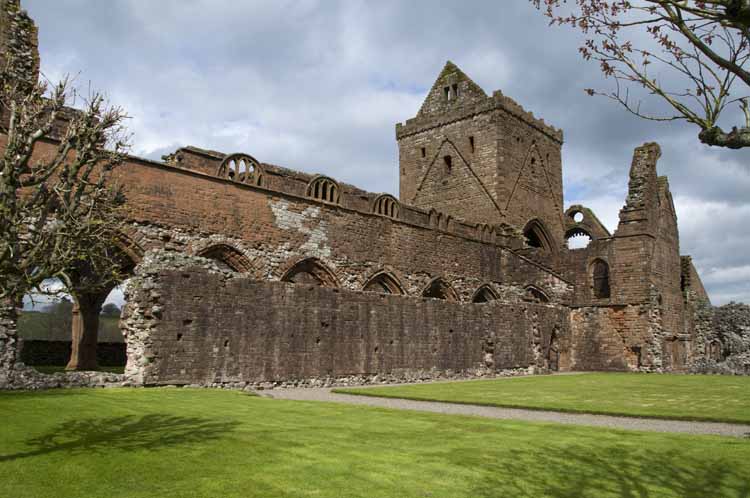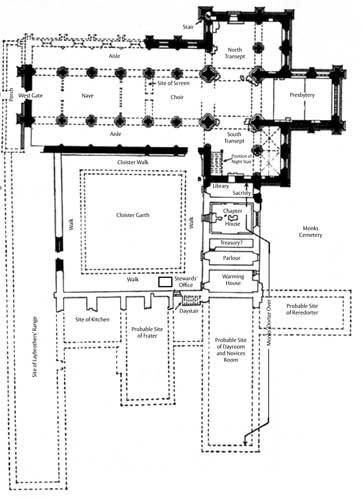Cistercian Abbey at Sweetheart, Dumfries and Galloway, Scotland,
was founded in 1273 by Lady Dervorguilla and it was the last
Cistercian abbey to be founded in Scotland. It was founded in memory
of her late husband, John Balliol (d. 1268) and it was one of a
number of charitable acts her performed in his memory. Following the death of
her husband, Dervorguilla had his heart embalmed and placed in a
silver and ivory casket which she carried with her at all times.
When she died in 1289 she was laid to rest, with the casket, in
front of the High Altar of the abbey church. The monks chose to name
the abbey Dulce Cor or ‘Sweetheart’ in honour of her memory. John
Balliol was a generous benefactor himself. During his lifetime he
founded Balliol College in Oxford, which Dervorguilla continued to
endow after his death. Dervorguilla is best known as the mother of
John Balliol (d. 1313) who was set on the Scottish throne in 1292 at
the behest of King Edward I. He was deposed four years later by
Edward when he failed to toe the line.
The first monks arrived at
the abbey from Dundrennan and apparently worked quickly to construct
the abbey. The buildings could hardly have been completed when, in
1300, King Edward I stopped at the abbey for a night during the
Scottish War of Independence. In 1308 the monks were to complain
that the king’s troops had caused damage to the abbey amounting to
more than £5000 through the burning of their granges and destruction
of their goods in war. It is likely that the monks exaggerated the
extent of the damage for the original church building of the late
thirteenth century still stands in part today. In any case the monks
never received the compensation they were looking for.
Towards the end of the 14th century the abbey found a powerful
patron in Archibald, earl of Douglas, known as ‘Archibald the Grim’ or
‘Black Archibald’. He was said to have done so much for the abbey that
he was regarded as Sweetheart’s second founder. In 1397 the abbey
buildings were struck by lightening and severely damaged by the
resulting fire. In the following year, 4 July 1398, the abbot received
the mitre. The last pre-Reformation abbot, John Brown, resigned in 1565,
whereupon Gilbert Brown became commendator and titular abbot. Gilbert
remained an ardent Catholic and allowed the church to be used for
Catholic worship for many years after the Reformation had taken place.
In 1579 it was reported that there was still a High Altar within the
abbey church, though this was removed some years later. In 1586 the
abbey was granted to William Lesley and Gilbert Brown was exiled to
France for continued participation in Catholic rites. He returned two
years later only to be exiled again in the following year. In 1608
Gilbert returned to Sweetheart, he was once more arrested but on account
of his old age was allowed to remain at the monastery. It was at this
time that the last of the monks were forced to leave the monastery,
although Gilbert was found still saying mass in 1609. He was exiled for
the third and last time and died in France in 1612. It is believed that
it was his obstinacy which ‘probably ensured that Sweetheart was the
last British monastery at which mass continued to be said after its
official abolition in Scotland in 1560’.
The Abbey adheres to Cistercian principles of austerity
but it also has some fine flourishes including the stone tracery in the
presbytery windows, the ingenious circular window above the south
transept, and the impressive west front. The Abbey's church is substantially complete and it stands
almost as it was originally constructed, apart from some remodelling
carried out after the fire at the end of the fourteenth century. The
west front of the church stands to its full height and the south
transept still retains its ribbed vaulting. It is in that part of the
church that the 16th century effigy of Lady Dervorguilla now stands
(albeit headless), clasping the casket to her chest. This monument
replaces the thirteenth-century original which was sadly lost. The chief
remains of the monastic buildings consist of the inner wall of the south
range, and the lower walls of the parts of the east range closest to the
church. To the north and north-west of the church is a long stretch of
the outer precinct wall, which is the most extensive survival of a
precinct wall of any Scottish Cistercian abbey. Another point of
interest is the arms of ‘Archibald the Grim’ which can still be seen
above the doorway of the west range. The site is now managed by Historic
Scotland and is open to the public on a regular basis.
In the following image the above ground remains of the
abbey are in black:
Source:


University of Sheffield -
The Cistercians in Yorkshire
Project
Richardson, J. 2007. Sweetheart Abbey.